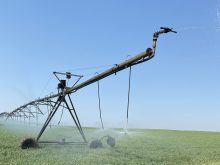Irrigation canals were shut down several weeks early in September last year, limiting ability to produce electricity
MEDICINE HAT — Hydropower in Alberta makes up a small portion of electricity production in the province but it’s still an important source of energy.
Recent low levels on southern Alberta rivers have affected the amount of electricity generated by Irrican Power, owned by the St. Mary River and Raymond irrigation districts, and by TransAlta.
In usual years, Irrican produces on average 29 megawatts of energy at three facilities over the 155-day period corresponding with the irrigation season, said St. Mary River Irrigation District general manager David Westwood.
Read Also

Huge Black Sea flax crop to provide stiff competition
Russia and Kazakhstan harvested huge flax crops and will be providing stiff competition in China and the EU.
“We generate enough that we could supply about 14,000 households in a year,” said Westwood during a presentation at the Alberta Irrigation District Association meeting in February.
In wetter years, when irrigation demand is at its least, power generation drops. Last year’s dry conditions brought heavy demand early in the season, reducing the ability to produce power and depleting reservoirs.
The SMRID and Raymond Irrigation District shut down their irrigation canals several weeks early in September, further limiting the systems’ ability to produce hydropower.
“We normally go for 155 days but we had our largest plant, Raymond, was only able to operate for 90 days. We actually had to shut it down on Aug. 11,” said Westwood.
The Chin hydro plant closed two weeks later for the same reason but crews were able to keep a third plant running until the district’s shut down, though at reduced rates.
This year doesn’t look good for electrical production and Westwood said the power company is “preparing ourselves for a less than optimum Irrican production year.”
However, Westwood said 2023 was the second highest revenue year due to high electricity prices in Alberta’s deregulated market, into which Irrican sells.
The issues for TransAlta are different. It operates 14 hydro plants with capacity to produce 800 MW province-wide.
TransAlta representative Kevin Wisener said there are 11 hydro generating facilities on the Bow River upstream of Calgary and reservoirs are managed to meet electricity demand.
Traditionally, reservoirs are drawn down in the lead-up to spring runoff and storage is replenished from the mountain snowpack in April and May.
“This time of year, we typically have 240,000 acre feet in our Bow system reservoirs and we are about 30,000 below that, which represents a 13 percent deficit,” said Wisener.
In 2023, TransAlta produced 140,000 fewer MW hours than the year before.
“That’s a 20 percent reduction compared with 2022,” said Wisener.
Compared with 20-year averages, the reduction is even greater and roughly twice that amount, he added.
Wisener said the company is developing procedures to deal with possible reduced flows on the Bow this year to balance power production with the downstream water needs of municipalities and irrigators.


















